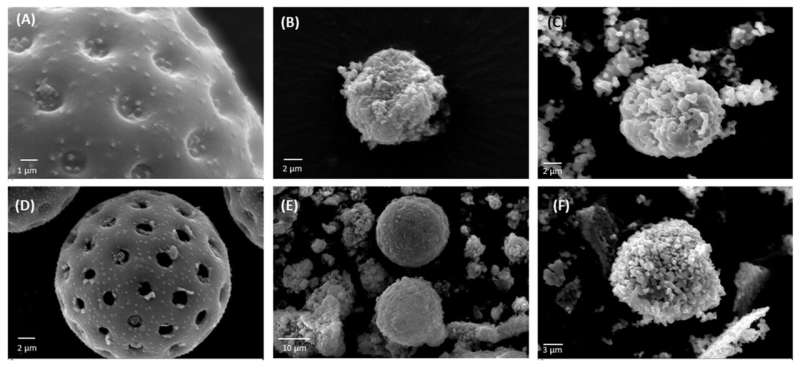This article has been reviewed according to Science X's editorial process and policies. Editors have highlighted the following attributes while ensuring the content's credibility:
fact-checked
peer-reviewed publication
trusted source
proofread
Pollen is a promising sustainable tool in the bone regeneration process

A new study has shown pollen grains can be used as green templates for producing biomaterials, showcasing their potential to support drug delivery and bone regeneration.
With an increasingly aging population, bone fractures are becoming more common. Bone is generally able to self-repair but if the fracture is too big or the person affected too fragile, as for example people with osteoporosis, the use of bone fillers can help.
Hydroxyapatite (HAp) is an inorganic mineral present in human bone and teeth, which can be used to support bone regeneration. It makes up somewhere between 65% and 70% of the weight of human bone. Health care professionals often use synthetic and natural HAp when carrying out bone repair treatments.
A team at the University of Portsmouth has worked with international colleagues to explore sustainable ways to improve the process.
They examined the feasibility of using pollen grains as bio-templates for growing calcium phosphate minerals in the lab—particularly hydroxyapatite (HAp) and β-tricalcium phosphate (TCP), which are types of calcium phosphate used for bone repair.
Hollow structures like pollen have demonstrated great potential in drug delivery due to their high surface-to-volume ratio and low density. The organic substance is also resilient to heat and various acids and bases.
Lead author Dr. Marta Roldo, Associate Professor in Biomaterials in the School of Pharmacy and Biomedical Sciences at the University of Portsmouth, said, "Pollen grains play an important role in the reproduction of seed plants by protecting the genetic material. Because of this they have a highly resilient external shell that protects the pollen from environmental injury caused by microbial damage, extreme temperatures, and dehydration.
"We've shown this shell can be an effective and sustainable bio-template for growing life-changing minerals."
During the in-vitro study, ragweed and lamb's quarter pollen grains were chosen as templates due to their distinct shapes.
The calcification process resulted in well-defined spherical hollow capsules derived from pollen. After calcination—where the capsules were heated and purified—the team was left with calcium phosphate made up of HAp and TPC.
Characterization techniques used by the team included X-ray diffraction, scanning electron microscopy, Fourier-transform infrared spectroscopy, and thermal gravimetric analysis.
"We were able to form these spherical shapes that were hollow inside," explained Dr. Roldo.
"So, if you compare it to a normal process, our product is going to be a lot lighter and present an internal cavity that in other bone regeneration materials has been shown to favor bone mineral deposition.
"The chemical structure is also a mix between hydroxyapatite and calcium phosphate, with the latter degrading quite fast to release the ions required for the production of new bone and the former degrading slower and acting as a reservoir of ions to be released slowly so that bone regeneration can be sustained in time."
The paper, published in the journal Biomimetics, says further experiments would be needed to explore how to best use these materials in bone regeneration applications.
Future work will focus on testing if this novel biomimetic material could support enhanced bone integration and regeneration around an implant, in order to decrease the patient's likelihood of requiring revision surgery in the future.
More information: Arianna De Mori et al, Sporopollenin Capsules as Biomimetic Templates for the Synthesis of Hydroxyapatite and β-TCP, Biomimetics (2024). DOI: 10.3390/biomimetics9030159
Journal information: Biomimetics
Provided by University of Portsmouth





















